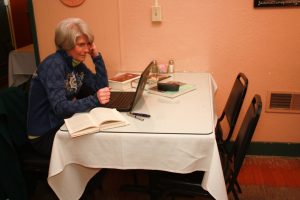 I’m hard at work on a new young adult biography and drowning in research! Before I attempted my first longer biography (The Brave Escape of Edith Wharton) research for shorter pieces was a simple task consisting of three steps: create a list of the books and articles I needed to read, find the books and articles I needed to read, and (finally!) READ THEM!
I’m hard at work on a new young adult biography and drowning in research! Before I attempted my first longer biography (The Brave Escape of Edith Wharton) research for shorter pieces was a simple task consisting of three steps: create a list of the books and articles I needed to read, find the books and articles I needed to read, and (finally!) READ THEM!
When it comes to a longer work, those three steps are just the beginning. For the biography I’m currently at work on, I’ve (mostly) created my bibliography and am about two thirds of the way through the reading of it. And I am drowning in information! As I read and underline and write notes in the margins of books and photocopies, a flood of interesting stuff is threatening to pull me under. If I don’t get things under control, I know exactly what will happen: When I begin writing I will be permanently stalled by the thought: I know that fact/quote/incident is somewhere but I can’t remember where!!! For me, the challenge in writing a longer nonfiction work is organizing my research material so that I can lay my hands on what I need exactly when I need it.
Half the desktop on my computer is now filled with various documents that I’m hoping will keep me afloat:
The first of these documents (i.e. the first life-preserver to keep me from drowning in research!) is a simple timeline. I start with 20 or 30 key events in my subject’s life: birth, significant moves from place to place, death of close relatives, professional breakthroughs, marriage, birth of children, death, etc. Those years are in boldface. Then I insert minor events between the boldfaced main-event years. After that, I insert historical events from sources I’m reading that help me understand the period or the place. The timeline for my work in progress is 47 pages long and counting. Sometimes a related historical incident comes at a key point in my subject’s life and I wouldn’t have realized it without a timeline. It was the timeline for The Brave Escape… that showed me Edith Wharton’s older brother’s name appeared on the list of people with “birth, background, and breeding” just after his wife had caught him having an affair. A good timeline brings seemingly random events together in some very interesting ways.
Next I have a document called “Chapter Notes for Future Reference,” with a brief heading for each proposed chapter of my book summarizing the years and key events I want to cover. As I discover possible interesting ways of presenting the material for each chapter, I insert it. When I made the discovery about Edith’s supposedly high society brother and his affair, I immediately made a note under chapter 4 reminding myself about this incident and suggesting that I use it to underscore how badly Old New York society was crumbling.
Last, I have a document for each book or article I’ve read with all underlined passages from the book typed (painstakingly!) under subject headings. Each document is entitled “Subject Notes for [name of the book].” These documents (and there can be dozens of them depending upon how many major books I read) run anywhere from 10 to 200 pages. As I begin writing a chapter, I usually have an idea about what theme or issue I might want to focus on. I scan through the “Subject Notes” documents, sometimes cutting and pasting key quotes from different books onto a master document that will give me many viewpoints on the issue or theme. My subject’s autobiography might say one thing; a history text from the period in which my subject lived might say another; a contemporary history text might say a third. I need all of them laid out before me in order to make an educated call on what stand I might decide to take.
I’ve discovered the hard way that it’s not the number of sources I read but how adept I am at cataloging the material contained in those sources that makes for useful research.

